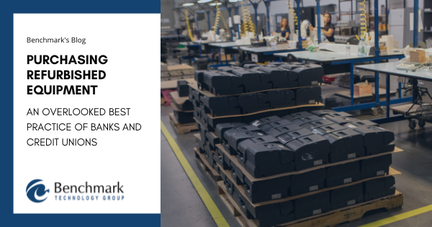By John ManganielloDirector, Project Services, Benchmark Technology Group, Inc.  As industry veterans predict a year of mergers and acquisitions, many financial institutions are taking steps to improve their resilience and agility as they contend with reduced deposits and higher interest rates. Many of them seek to become more agile to take advantage of emerging tech and growth opportunities. From an operational standpoint, technology strategy and device management are crucial to productivity. From an employee standpoint, very little defines a bank more than the effectiveness of its provided hardware and software infrastructure. Thus, it’s crucial to have comprehensive device management capabilities in addition to a flexible and forward-looking technology strategy. With this infrastructure in place, banks and credit unions can ensure that their employees and customers have access to the technology and support they demand while also minimizing downtime. Harnessing their technology (including hardware, software, and mobile devices), financial institutions can better address security and fraud prevention, while providing a more robust online banking experience to their customer base. By John ManganielloDirector, Project Services, Benchmark Technology Group, Inc.  As industry veterans predict a year of mergers and acquisitions, many financial institutions are taking steps to improve their resilience and agility as they contend with reduced deposits and higher interest rates. Many of them seek to become more agile to take advantage of emerging tech and growth opportunities. From an operational standpoint, technology strategy and device management are crucial to productivity. From an employee standpoint, very little defines a bank more than the effectiveness of its provided hardware and software infrastructure. Thus, it’s crucial to have comprehensive device management capabilities in addition to a flexible and forward-looking technology strategy. With this infrastructure in place, banks and credit unions can ensure that their employees and customers have access to the technology and support they demand while also minimizing downtime. Harnessing their technology (including hardware, software, and mobile devices), financial institutions can better address security and fraud prevention, while providing a more robust online banking experience to their customer base. Benchmark's Predictions, From Interest Rates to Services and Devices 2023 proved tough for financial institution (FI) leaders. As banks and credit unions faced mounting pressures due to inflation, regulatory considerations, and higher interest rates, it got more challenging to stay on course with technology investments. However, we believe bankers will find 2024 to be a much better environment, particularly if they act strategically to leverage the right partners and resources. Here are a few things our Benchmark team members have seen in their crystal ball for the upcoming year: “The banking industry faced significant challenges in executing larger projects, many of which were deferred to 2024 or strategically divided between the two years. With the surge in bank mergers, the need for hardware and services standardization became paramount, compelling financial institutions to seek comprehensive solutions. Recognizing the value of partnerships, banks are now actively engaging with companies offering full-service packages. These encompass everything from sourcing new equipment at competitive prices to providing repair options, facilitating installations and implementing buy-back programs for retired hardware. An interesting trend observed in the past 12 months is banks’ and credit unions’ willingness to invest in refurbished hardware, marking a departure from traditional preferences. Looking ahead, the industry anticipates the continuation of mergers and acquisitions in 2024, emphasizing the importance of adaptability and collaboration. The spotlight on fraud prevention is set to intensify, with manufacturers actively developing innovative products geared towards safeguarding branches from emerging threats.”
Stephanie Johnson, Senior Account Executive Benchmark's Predictions, From Interest Rates to Services and Devices 2023 proved tough for financial institution (FI) leaders. As banks and credit unions faced mounting pressures due to inflation, regulatory considerations, and higher interest rates, it got more challenging to stay on course with technology investments. However, we believe bankers will find 2024 to be a much better environment, particularly if they act strategically to leverage the right partners and resources. Here are a few things our Benchmark team members have seen in their crystal ball for the upcoming year: “The banking industry faced significant challenges in executing larger projects, many of which were deferred to 2024 or strategically divided between the two years. With the surge in bank mergers, the need for hardware and services standardization became paramount, compelling financial institutions to seek comprehensive solutions. Recognizing the value of partnerships, banks are now actively engaging with companies offering full-service packages. These encompass everything from sourcing new equipment at competitive prices to providing repair options, facilitating installations and implementing buy-back programs for retired hardware. An interesting trend observed in the past 12 months is banks’ and credit unions’ willingness to invest in refurbished hardware, marking a departure from traditional preferences. Looking ahead, the industry anticipates the continuation of mergers and acquisitions in 2024, emphasizing the importance of adaptability and collaboration. The spotlight on fraud prevention is set to intensify, with manufacturers actively developing innovative products geared towards safeguarding branches from emerging threats.”
Stephanie Johnson, Senior Account Executive  Banks and credit unions need better ways to manage cash. It's true: the number of cash transactions has declined, but with fewer personnel, there's still too much cash to keep up with when using manual processes or antiquated cash automation systems that don’t operate seamlessly. Also, higher turnover means there may be fewer people with expert cash handling skills to process currency accurately and efficiently. Cash management can account for 5-10% of a branch's costs. The reporting required to understand and control it within the branch can take hours as managers gather data from different systems or paper logs. The risk of inaccuracy is high; and the tedium of this work can increase attrition rates. Forty-five percent of bank executives say they're using outdated solutions. Upgrading tech has become a priority. Yet, many financial institutions have no plans to replace or optimize outdated cash automation solutions and, as a result, miss out on systems that offer a range of benefits and increase cash visibility across the organization. Today, there's good news. With the rise of advanced cash automation solutions, financial institutions can attain greater control of cash operations than ever before.  Banks and credit unions need better ways to manage cash. It's true: the number of cash transactions has declined, but with fewer personnel, there's still too much cash to keep up with when using manual processes or antiquated cash automation systems that don’t operate seamlessly. Also, higher turnover means there may be fewer people with expert cash handling skills to process currency accurately and efficiently. Cash management can account for 5-10% of a branch's costs. The reporting required to understand and control it within the branch can take hours as managers gather data from different systems or paper logs. The risk of inaccuracy is high; and the tedium of this work can increase attrition rates. Forty-five percent of bank executives say they're using outdated solutions. Upgrading tech has become a priority. Yet, many financial institutions have no plans to replace or optimize outdated cash automation solutions and, as a result, miss out on systems that offer a range of benefits and increase cash visibility across the organization. Today, there's good news. With the rise of advanced cash automation solutions, financial institutions can attain greater control of cash operations than ever before. Purchasing Refurbished Banking Equipment: An Overlooked Best Practice of Banks and Credit Unions9/28/2022
 Many leaders at banks and credit unions have never fully explored the advantages of purchasing refurbished banking equipment. However, in today’s business environment, this option must be considered, especially as you strive to keep your branches running smoothly and stay on track with new technology rollouts, conversions or upgrades that modernize your financial institution and enhance its competitiveness. For every bank or credit union, having the right hardware is business critical, whether it’s scanners, teller printers or signature pads. You need to make sure every device functions effectively every day so that customer interactions happen seamlessly. Malfunctioning or insufficient quantities of equipment can frustrate tellers and customers, taking the focus away from the customers’ needs and hampering operational efficiency and growth. However, with supply chain challenges caused by the ongoing pandemic and inflation, it might be harder to acquire devices that were easy to find a year ago. Plus, prices and surcharges are increasing at dizzying rates. Competition for new equipment is heating up, with some organizations hoarding equipment by acquiring a “just-in-case” supply. The good news? Buying new is not the only option. Purchasing Refurbished Banking Equipment: An Overlooked Best Practice of Banks and Credit Unions9/28/2022
 Many leaders at banks and credit unions have never fully explored the advantages of purchasing refurbished banking equipment. However, in today’s business environment, this option must be considered, especially as you strive to keep your branches running smoothly and stay on track with new technology rollouts, conversions or upgrades that modernize your financial institution and enhance its competitiveness. For every bank or credit union, having the right hardware is business critical, whether it’s scanners, teller printers or signature pads. You need to make sure every device functions effectively every day so that customer interactions happen seamlessly. Malfunctioning or insufficient quantities of equipment can frustrate tellers and customers, taking the focus away from the customers’ needs and hampering operational efficiency and growth. However, with supply chain challenges caused by the ongoing pandemic and inflation, it might be harder to acquire devices that were easy to find a year ago. Plus, prices and surcharges are increasing at dizzying rates. Competition for new equipment is heating up, with some organizations hoarding equipment by acquiring a “just-in-case” supply. The good news? Buying new is not the only option.
|
|







 RSS Feed
RSS Feed

